It looks like you're using an Ad Blocker.
Please white-list or disable AboveTopSecret.com in your ad-blocking tool.
Thank you.
Some features of ATS will be disabled while you continue to use an ad-blocker.
share:
Space is a dangerous arena, as many know of the asteroids and meteors that time and again enter our atmosphere, dazzling our senses. Some, however,
are large and dense enough to make contact with the surface, surviving the chaos of atmospheric entry.
Some have witnessed firsthand, meteors and other objects burn up in the skies, while others have had the privilege of seeing actual impact craters, like Meteor crater in Arizona:
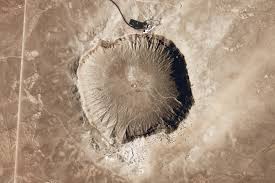
However spectacular this crater may be, it pales in comparison to others, as it spans only 3/4 of a mile and is 500 feet deep, created by a mere 50m diameter, nickel rich meteorite some 50,000 years ago.
To really get an idea of how massive some impact craters are, we will have to take a look at other celestial bodies in our solar system, and on occasion, they may not be as obvious as the meteor crater above.
MERCURY: CALORIS BASIN
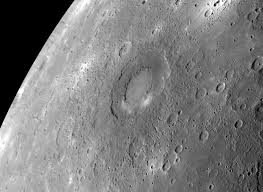
The estimated size of the impacting asteroid is about 65 miles in diamater and the age of the crater, roughly 3.9 billion years which coincides with what is known as the late heavy bombardment period during the earliest years of our solar system.
VENUS: MEAD IMPACT BASIN

While much smaller than the Caloris basin, this impact crater holds the top spot on Venus' surface for largest Venusian crater.
EARTH: VREDEFORT IMPACT BASIN
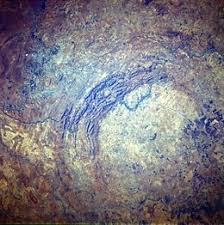
Many of you are familiar with the Chicxlub impact crater on the Yucatan peninsula, hypothesized to have killed off the dinosaurs. However, at roughly 90 miles in diameter, it is a solid 100 miles smaller than the lesser known Vredefort impact basin on the southern tip of Africa. The impact crater is estimated to be roughly 2 billion years old or post heavy bombardment period. Due to the Earth's dynamic atmosphere and erosive elements, along with geologic processes, the impact basin is much harder to discern.
Continued below
Some have witnessed firsthand, meteors and other objects burn up in the skies, while others have had the privilege of seeing actual impact craters, like Meteor crater in Arizona:

However spectacular this crater may be, it pales in comparison to others, as it spans only 3/4 of a mile and is 500 feet deep, created by a mere 50m diameter, nickel rich meteorite some 50,000 years ago.
To really get an idea of how massive some impact craters are, we will have to take a look at other celestial bodies in our solar system, and on occasion, they may not be as obvious as the meteor crater above.
MERCURY: CALORIS BASIN

Caloris Planitia is a plain within a large impact basin on Mercury, informally named Caloris, about 1,550 km (960 mi) in diameter.[1] It is one of the largest impact basins in the Solar System.
The estimated size of the impacting asteroid is about 65 miles in diamater and the age of the crater, roughly 3.9 billion years which coincides with what is known as the late heavy bombardment period during the earliest years of our solar system.
VENUS: MEAD IMPACT BASIN

This Magellan image mosaic shows the largest (275 kilometers in diameter [170 miles]) impact crater known to exist on Venus at this point in the Magellan mission.
While much smaller than the Caloris basin, this impact crater holds the top spot on Venus' surface for largest Venusian crater.
EARTH: VREDEFORT IMPACT BASIN

Many of you are familiar with the Chicxlub impact crater on the Yucatan peninsula, hypothesized to have killed off the dinosaurs. However, at roughly 90 miles in diameter, it is a solid 100 miles smaller than the lesser known Vredefort impact basin on the southern tip of Africa. The impact crater is estimated to be roughly 2 billion years old or post heavy bombardment period. Due to the Earth's dynamic atmosphere and erosive elements, along with geologic processes, the impact basin is much harder to discern.
Continued below
edit on 6212018 by CreationBro because: (no reason given)
a reply to: CreationBro
THE MOON: SOUTH-POLE AITKEN BASIN
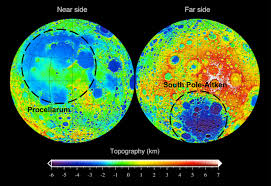
This impact basin is puzzling to scientists as samples and data show some bizarre composition of the basin, including perplexities about how it formed.
MARS: HELLAS PLANITIA

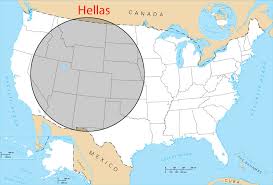
Theories have arisen that this basin used to be a giant Martian lake. Perhaps a good place to investigate signs of past life?
There are many more notable impact craters in our solar system, A quick search will yield a lot of information. Should you be interested in learning more about impact craters and how they go about finding and determining them on Earth, check out this link to the Earth Impact database:
www.passc.net...
Source material:
www.nasa.gov...
www.jpl.nasa.gov...
www.cs.mcgill.ca...
meteorcrater.com...
en.m.wikipedia.org...
THE MOON: SOUTH-POLE AITKEN BASIN

The South Pole–Aitken basin is an impact crater on the far side of the Moon. At roughly 2,500 km (1,600 mi) in diameter and 13 km (8.1 mi) deep, it is one of the largest known impact craters in the Solar System. It is the largest, oldest, and deepest basin recognized on the Moon.
This impact basin is puzzling to scientists as samples and data show some bizarre composition of the basin, including perplexities about how it formed.
This has suggested to some that the basin was not formed by a typical high-velocity impact, but may instead have been formed by a low-velocity projectile around 200 km in diameter that hit at a low angle (about 30 degrees or less), and hence did not dig very deeply into the Moon.
MARS: HELLAS PLANITIA


Hellas Planitia is a plain located within the huge, roughly circular impact basin Hellas[a] located in the southern hemisphere of the planet Mars.[3] Hellas is the third or fourth largest impact crater and the largest visible impact crater known in the Solar System. The basin floor is about 7,152 m (23,465 ft) deep, 3,000 m (9,800 ft) deeper than the Moon's South Pole-Aitken basin, and extends about 2,300 km (1,400 mi) east to west.
Theories have arisen that this basin used to be a giant Martian lake. Perhaps a good place to investigate signs of past life?
There are many more notable impact craters in our solar system, A quick search will yield a lot of information. Should you be interested in learning more about impact craters and how they go about finding and determining them on Earth, check out this link to the Earth Impact database:
www.passc.net...
Source material:
www.nasa.gov...
www.jpl.nasa.gov...
www.cs.mcgill.ca...
meteorcrater.com...
en.m.wikipedia.org...
edit on 6212018 by CreationBro because: (no reason given)
a reply to: CreationBro
Cool.
This one's here on earth.
www.pnas.org...
Figure1
Download figure Open in new tab Download powerpoint
The Chicxulub crater, shown here in an artist’s conception, formed a little more than 66 million years ago when a meteorite plowed into Earth’s surface, wiping out 75% of all species on the planet. But recent findings suggest the impact actually could have helped generate the conditions necessary for the creation of life itself. Image courtesy of Detlev van Ravenswaay/ScienceSource.
From this link www.pnas.org...
Cool.
This one's here on earth.
www.pnas.org...
Figure1
Download figure Open in new tab Download powerpoint
The Chicxulub crater, shown here in an artist’s conception, formed a little more than 66 million years ago when a meteorite plowed into Earth’s surface, wiping out 75% of all species on the planet. But recent findings suggest the impact actually could have helped generate the conditions necessary for the creation of life itself. Image courtesy of Detlev van Ravenswaay/ScienceSource.
From this link www.pnas.org...
edit on 21-6-2018 by blackcrowe because: (no reason given)
a reply to: blackcrowe
The Chicxulub impact event was huge. The Vredefort was so long ago, life here on Earth was mostly just microorganisms. However that impact on the Yucatan caused a huge stir within the ecosystem and life here, no doubt about it.
Thanks for that link by the way.
The Chicxulub impact event was huge. The Vredefort was so long ago, life here on Earth was mostly just microorganisms. However that impact on the Yucatan caused a huge stir within the ecosystem and life here, no doubt about it.
Thanks for that link by the way.
edit on 6212018 by CreationBro because: (no reason given)
a reply to: CreationBro
I always hoped I would be sitting in a comfortable chair, with a cup of coffee, outside to see an ELE-type meteor come plowing into us....
I now know I want it to be a "low-velocity projectile"...that would be even cooler!!!
Thank you for this informative thread!! Nice job..
Peace
I always hoped I would be sitting in a comfortable chair, with a cup of coffee, outside to see an ELE-type meteor come plowing into us....
I now know I want it to be a "low-velocity projectile"...that would be even cooler!!!
Thank you for this informative thread!! Nice job..
Peace
a reply to: CreationBro
And. A theory about the moon being an impact event is an interesting one. It might have even triggered earths core into action too.
And. A theory about the moon being an impact event is an interesting one. It might have even triggered earths core into action too.
a reply to: operation mindcrime
Exactly!
Maybe itll come within arms reach and just very slowly cruise by, maybe even give the rock a tickle
Exactly!
Maybe itll come within arms reach and just very slowly cruise by, maybe even give the rock a tickle
a reply to: CreationBro
Just found this.
www.space.com...
It's NASA's new plans to destroy earthbound asteroids.
It might be a more logical idea than trying to conquer space.
Just found this.
www.space.com...
It's NASA's new plans to destroy earthbound asteroids.
It might be a more logical idea than trying to conquer space.
a reply to: blackcrowe
Nice find!
Did I read FEMA, prepare the country for the potential consequences, 10 year plan.....oh boy!! Let the good times roll!!!
Peace
Nice find!
Did I read FEMA, prepare the country for the potential consequences, 10 year plan.....oh boy!! Let the good times roll!!!
Peace
Wow what an incredible and informative post. Thanks for sharing.
a reply to: CreationBro
a reply to: CreationBro
edit on 05/07/18 by FreeFalling because: (no reason given)
originally posted by: blackcrowe
a reply to: CreationBro
Just found this.
www.space.com...
It's NASA's new plans to destroy earthbound asteroids.
It might be a more logical idea than trying to conquer space.
Critically important that is for sure. As the saying goes, it's not a matter of if, but when.
a reply to: CreationBro
I don't know how true this is and I don't have any source, either. A few years back I was readding about how ssoome gold and metal deposits were due to meteors hitting the earth. The logic was that earth's interior is molten and all the iron and heavy metals are in the core of the planet. Anything like that on the surface must have arrived from a meteor strike. If this is true, the planet must be covered with meteors even more than the moon. It really doesn't make sense to me that every planet and moon could have so many craters yet the earth has only a few.
I don't know how true this is and I don't have any source, either. A few years back I was readding about how ssoome gold and metal deposits were due to meteors hitting the earth. The logic was that earth's interior is molten and all the iron and heavy metals are in the core of the planet. Anything like that on the surface must have arrived from a meteor strike. If this is true, the planet must be covered with meteors even more than the moon. It really doesn't make sense to me that every planet and moon could have so many craters yet the earth has only a few.
a reply to: toms54
Earth has plate tectonics, its surface recycles.
Earth has weather, its surface erodes.
Earth has an atmosphere which prevents a lot of meteors from reaching its surface.
Earth has large oceans which cover most of its surface.
The Moon shows the scars of billions of years. The Earth does not.
It really doesn't make sense to me that every planet and moon could have so many craters yet the earth has only a few.
Earth has plate tectonics, its surface recycles.
Earth has weather, its surface erodes.
Earth has an atmosphere which prevents a lot of meteors from reaching its surface.
Earth has large oceans which cover most of its surface.
The Moon shows the scars of billions of years. The Earth does not.
edit on 6/21/2018 by Phage because: (no reason given)
edit on 6/21/2018 by Phage because: (no reason given)
originally posted by: Phage
a reply to: toms54
It really doesn't make sense to me that every planet and moon could have so many craters yet the earth has only a few.
Earth has plate tectonics, its surface recycles.
Earth has weather, its surface erodes.
Earth has an atmosphere which prevents a lot of meteors from reaching its surface.
The Moon shows the scars of billions of years. The Earth does not.
That's what I mean. They are all over. When you look at maps of these metal deposits sometimes you see round lakes that could be craters.
originally posted by: toms54
originally posted by: Phage
a reply to: toms54
It really doesn't make sense to me that every planet and moon could have so many craters yet the earth has only a few.
Earth has plate tectonics, its surface recycles.
Earth has weather, its surface erodes.
Earth has an atmosphere which prevents a lot of meteors from reaching its surface.
The Moon shows the scars of billions of years. The Earth does not.
That's what I mean. They are all over. When you look at maps of these metal deposits sometimes you see round lakes that could be craters.
Could be. In my OP towards the end i provided a link to the Earth Impact Database. In it they have verified many craters due to sedimentary analysis, crater rims, concentric circular features, things called shatter cones, and more...however the database also contains many unverified impact craters on Earth, some have hypothesized crater rims where the banks and shores of various bodies of water are.
Here is a quick link to a list of unconfirmed impact craters on Earth and other details:
en.m.wikipedia.org...
edit on 6212018 by CreationBro because: (no reason given)
a reply to: toms54
The earth does get hit occasionally.
But. Much less than any other planetary body.
Earth is the safest place in our solar system. Probably our galaxy. And, maybe the entire universe.
It has a magnetosphere to shield against solar radiation.
It has a large moon.
It has a thick atmosphere. Made up of ozone layer, ionosphere and troposphere. All help shield from harmful solar rays,
The thick atmosphere also helps break up any rocks that try to hit the earth. Shooting stars is what you see when this happens.
Earth is 75 percent covered with water.
The 25 percent land. Is only 3 percent populated (by humans). And. The population is spread out all over the earth.
That's a great reason to stay on earth. Not trying to colonise another planet/moon. Where the chances of impacts are far greater than here on earth.
We find Mars rocks on earth.
Mars is constantly bombarded with debris from space. Some impacts are big enough to throw material off Mars' surface and be tossed into space. Do we find any earth rocks on Mars? (Not getting into Mars rover on earth).
Now. Does anyone still want to live in a dome on Mars? I don't.
There's nowhere quite like home.
The earth does get hit occasionally.
But. Much less than any other planetary body.
Earth is the safest place in our solar system. Probably our galaxy. And, maybe the entire universe.
It has a magnetosphere to shield against solar radiation.
It has a large moon.
It has a thick atmosphere. Made up of ozone layer, ionosphere and troposphere. All help shield from harmful solar rays,
The thick atmosphere also helps break up any rocks that try to hit the earth. Shooting stars is what you see when this happens.
Earth is 75 percent covered with water.
The 25 percent land. Is only 3 percent populated (by humans). And. The population is spread out all over the earth.
That's a great reason to stay on earth. Not trying to colonise another planet/moon. Where the chances of impacts are far greater than here on earth.
We find Mars rocks on earth.
Mars is constantly bombarded with debris from space. Some impacts are big enough to throw material off Mars' surface and be tossed into space. Do we find any earth rocks on Mars? (Not getting into Mars rover on earth).
Now. Does anyone still want to live in a dome on Mars? I don't.
There's nowhere quite like home.
I had the opportunity to visit one of the impact craters on Earth - the Kaali crater in
Estonia.

Besides it being very cool to see an actual impact crater with your eyes, this crater is notable in that it's one of the most recent impact event that left a crater - it occured a few thousand years ago and there were people living in that area.

Besides it being very cool to see an actual impact crater with your eyes, this crater is notable in that it's one of the most recent impact event that left a crater - it occured a few thousand years ago and there were people living in that area.
a reply to: wildespace
That's cool.
a more recent event was the Tunguska event. 110 years
'It is estimated the asteroid entered Earth's atmosphere traveling at a speed of about 33,500 miles per hour. During its quick plunge, the 220-million-pound space rock heated the air surrounding it to 44,500 degrees Fahrenheit. At 7:17 a.m. (local Siberia time), at a height of about 28,000 feet, the combination of pressure and heat caused the asteroid to fragment and annihilate itself, producing a fireball and releasing energy equivalent to about 185 Hiroshima bombs.
"That is why there is no impact crater," said Yeomans. "The great majority of the asteroid is consumed in the explosion."'
Taken from this link. science.nasa.gov...
That's cool.
a more recent event was the Tunguska event. 110 years
'It is estimated the asteroid entered Earth's atmosphere traveling at a speed of about 33,500 miles per hour. During its quick plunge, the 220-million-pound space rock heated the air surrounding it to 44,500 degrees Fahrenheit. At 7:17 a.m. (local Siberia time), at a height of about 28,000 feet, the combination of pressure and heat caused the asteroid to fragment and annihilate itself, producing a fireball and releasing energy equivalent to about 185 Hiroshima bombs.
"That is why there is no impact crater," said Yeomans. "The great majority of the asteroid is consumed in the explosion."'
Taken from this link. science.nasa.gov...
new topics
-
I sleep no more.
Philosophy and Metaphysics: 1 hours ago -
Canada caught red-handed manipulating live weather data and make it warmer
Fragile Earth: 1 hours ago -
Why Files Our Alien Overlords | How We Secretly Serve The Tall Whites
Aliens and UFOs: 3 hours ago -
Curse of King Tuts Tomb Solved
Ancient & Lost Civilizations: 4 hours ago -
What allies does Trump have in the world?
ATS Skunk Works: 4 hours ago
top topics
-
BIDEN Admin Begins Planning For January 2025 Transition to a New President - Today is 4.26.2024.
2024 Elections: 13 hours ago, 9 flags -
Big Storms
Fragile Earth: 14 hours ago, 8 flags -
Curse of King Tuts Tomb Solved
Ancient & Lost Civilizations: 4 hours ago, 6 flags -
Why Files Our Alien Overlords | How We Secretly Serve The Tall Whites
Aliens and UFOs: 3 hours ago, 6 flags -
Where should Trump hold his next rally
2024 Elections: 17 hours ago, 5 flags -
Canada caught red-handed manipulating live weather data and make it warmer
Fragile Earth: 1 hours ago, 5 flags -
What allies does Trump have in the world?
ATS Skunk Works: 4 hours ago, 2 flags -
I sleep no more.
Philosophy and Metaphysics: 1 hours ago, 1 flags
active topics
-
Gov Kristi Noem Shot and Killed "Less Than Worthless Dog" and a 'Smelly Goat
2024 Elections • 75 • : Xtrozero -
Mood Music Part VI
Music • 3117 • : TheWoker -
The Acronym Game .. Pt.3
General Chit Chat • 7759 • : F2d5thCavv2 -
Canada caught red-handed manipulating live weather data and make it warmer
Fragile Earth • 7 • : BeyondKnowledge3 -
BIDEN Admin Begins Planning For January 2025 Transition to a New President - Today is 4.26.2024.
2024 Elections • 24 • : NoCorruptionAllowed -
Why Files Our Alien Overlords | How We Secretly Serve The Tall Whites
Aliens and UFOs • 5 • : Ophiuchus1 -
Post A Funny (T&C Friendly) Pic Part IV: The LOL awakens!
General Chit Chat • 7139 • : underpass61 -
University of Texas Instantly Shuts Down Anti Israel Protests
Education and Media • 334 • : DBCowboy -
Curse of King Tuts Tomb Solved
Ancient & Lost Civilizations • 4 • : theatreboy -
A Warning to America: 25 Ways the US is Being Destroyed
New World Order • 31 • : JAY1980
